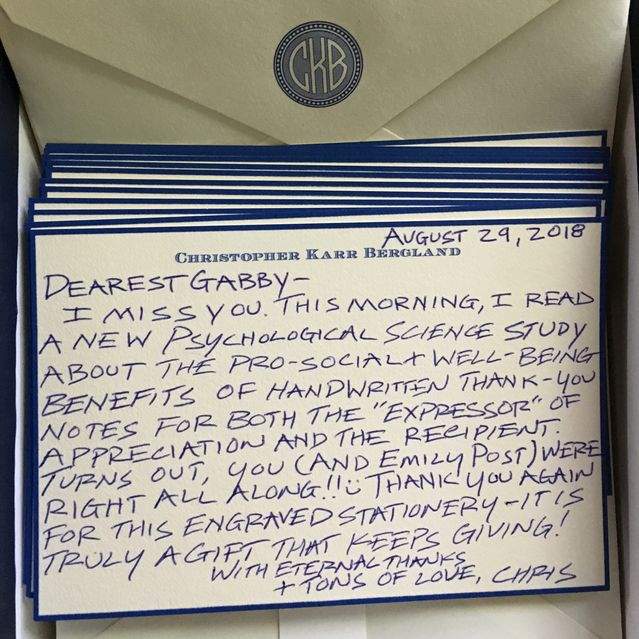Gratitude
Handwritten Thank-You Notes Have Surprising Consequences
The win-win benefits of handwritten notes tend to be underestimated.
Posted August 29, 2018

When was the last time you sent someone a handwritten "thank-you" note of gratitude or appreciation? This morning, I read about a new study on the underestimated benefits of handwritten cards that inspired me to dig out my old personalized stationery and get back in the habit of sending pen-to-paper notes expressing gratitude. This study, “Undervaluing Gratitude: Expressers Misunderstand the Consequences of Showing Appreciation,” was published in the journal Psychological Science.
The new research on the benefits of handwritten thank-you letters was led by Amit Kumar, assistant professor of marketing in the McCombs School of Business at the University of Texas in Austin. Kumar collaborated with Nicholas Epley, professor of behavioral science at the the University of Chicago Booth School of Business.
In the pre-internet era, I regularly mailed notes of thanks to people on engraved stationery that my grandparents had given me as a graduation present, along with a copy of How to Win Friends and Influence People. My grandmother, “Gabby,” was born at the turn of the 20th century in New England. She was a very "proper" student at Smith College in 1922, right around the time that Emily Post published her best-selling book, Etiquette. Gabby prided herself on having impeccable manners and put a premium on handwritten thank-you notes. She sent thank-you notes for everything. As much as I thought her rigid adherence to “etiquette” was a bit stuffy and over the top, I must admit that receiving her notes of appreciation always gave me a warm-and-fuzzy feeling of well-being.
After graduating from Hampshire College in the late 1980s, I moved to Greenwich Village in Manhattan. At the time, I self-identified as a renegade and "political activist," who lived a scrappy, hand-to-mouth existence. I didn't fit the Emily Post mold. But because I had boxes of free Crane’s stationery with my name engraved on top, I used these cards liberally. And, much like my grandmother, I found myself thanking people for random things in handwritten notes all the time.
At first, I was amazed by how strongly people responded to getting these personalized notes of appreciation. But it quickly became clear that sending handwritten notes created the ultimate win-win: Writing thank-you notes made me feel good, and it made recipients feel good, too. Emily Post and my grandmother were on to something!
Before her death in 1998, Gabby reordered more thank-you cards and gave me the original engraving plates from Crane & Company. Sadly, with the advent of the internet, email, and then text messaging, I slowly fell out of the habit of handwriting cards. Thankfully, I still have boxes of this unopened stationery in the bottom drawer of my desk that I'm going to start using again.
Most People Undervalue the Benefits of Handwritten "Thank-You" Notes
For their recent study, Kumar and Epley conducted three different experiments in which study participants wrote various letters expressing gratitude and then predicted how surprised, happy, or potentially awkward they thought the recipient would feel when he or she received a handwritten note of appreciation.
Their results showed that people expressing gratitude underestimated how pleasantly surprised recipients would be to receive a handwritten "thank you" and how positive the expression of gratitude made recipients feel. On the flip side, people who wrote thank-you letters overestimated the potential awkwardness that someone receiving a heartfelt thank-you note would experience.
Additionally, the researchers found that the prosocial gesture of expressing gratitude in a handwritten note boosts positive emotions and well-being for both the letter-writing “expresser” and the recipient of the stated appreciation.
Kumar and Epley speculate that egocentric bias often leads expressers of gratitude to systematically undervalue the positive impact that expressing appreciation and thankfulness has on recipients. As the authors write, “Wise decisions are guided by an accurate assessment of the expected value of action. Underestimating the value of prosocial actions, such as expressing gratitude, may keep people from engaging in behavior that would maximize their own — and others’ — well-being.” They hope that putting the benefits of handwritten "thank-you" notes in the spotlight will inspire people from all walks of life to express gratitude more frequently in their day-to-day lives.
"We looked at what's correlating with people's likelihood of expressing gratitude — what drives those choices — and what we found is that predictions or expectations of that awkwardness, that anticipation of how a recipient would feel — those are the things that matter when people are deciding whether to express gratitude or not," Kumar said in a statement. "What we saw is that it only takes a couple of minutes to compose letters like these, thoughtful ones and sincere ones. It comes at little cost, but the benefits are larger than people expect."
In an LA Times article, “Your 3-step plan to writing the perfect 'Thank You' note,” Lizzie Post — the great-great-grandaughter of Emily Post — breaks down three key ingredients for handwritten notes of appreciation.
The Anatomy of a "Thank-You” Note by Lizzie Post:
Step 1: Start with an opener or greeting: "It was so lovely to see you at Thanksgiving this year!"
Step 2: Thank them for the specific item given and tell them how you have already used the gift, or plan to: "Thank you for the lovely bowl. It is the perfect fall color for my dining room table, and I can't wait to enjoy it all season long."
Step 3: Then, add a closing. It's nice to include a wish for the future, but not obligatory: for example, "I look forward to visiting in the New Year and hope that you enjoy the holidays."
Although my grandmother passed away two decades ago, this morning I wrote her a posthumous thank-you note on the stationery she gave me after college as a personal example of these key ingredients.

I’m not an etiquette expert. But, intuitively, my thank-you notes tend to include the ingredients that Post suggests, along with a light-hearted, playful tone. For example, I generally try to include past, present, and future references and put the specific gift (or reason for appreciation) in a personalized context.
As mentioned, I’m embarrassed to admit that I haven’t sent anyone a handwritten thank-you note in eons. In fact, I haven’t handwritten anything for a long time. (My penmanship has clearly turned to chicken scratch!) That said, the latest study by Kumar & Epley has inspired me to start sending people handwritten thank-you notes more frequently. Hopefully, learning about the prosocial benefits of sending letters of appreciation will encourage you to do the same and will help to create an upward spiral of well-being that spreads from one person to another.
References
Amit Kumar and Nicholas Epley. “Undervaluing Gratitude: Expressers Misunderstand the Consequences of Showing Appreciation.” Psychological Science (First published online: June 27, 2018) DOI: 10.1177/0956797618772506




